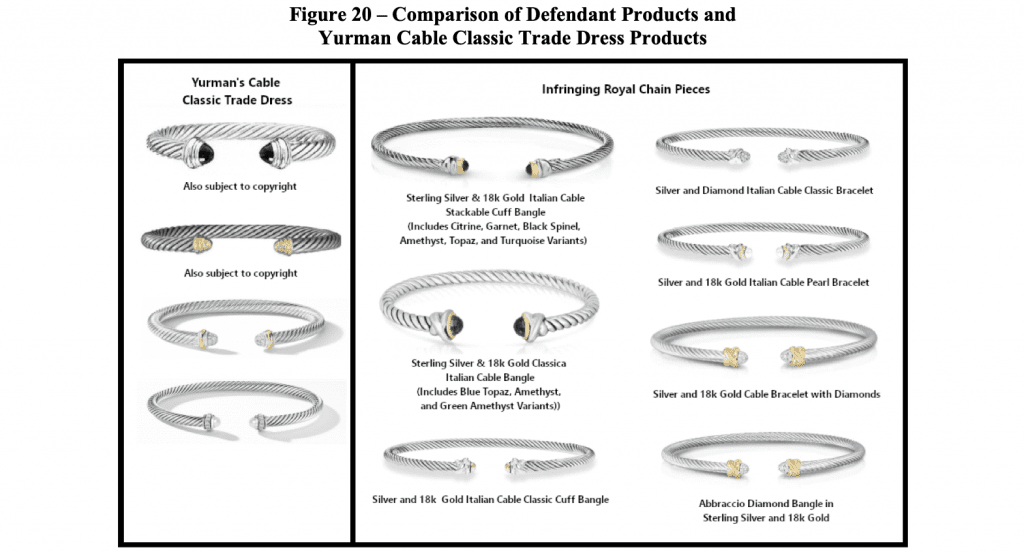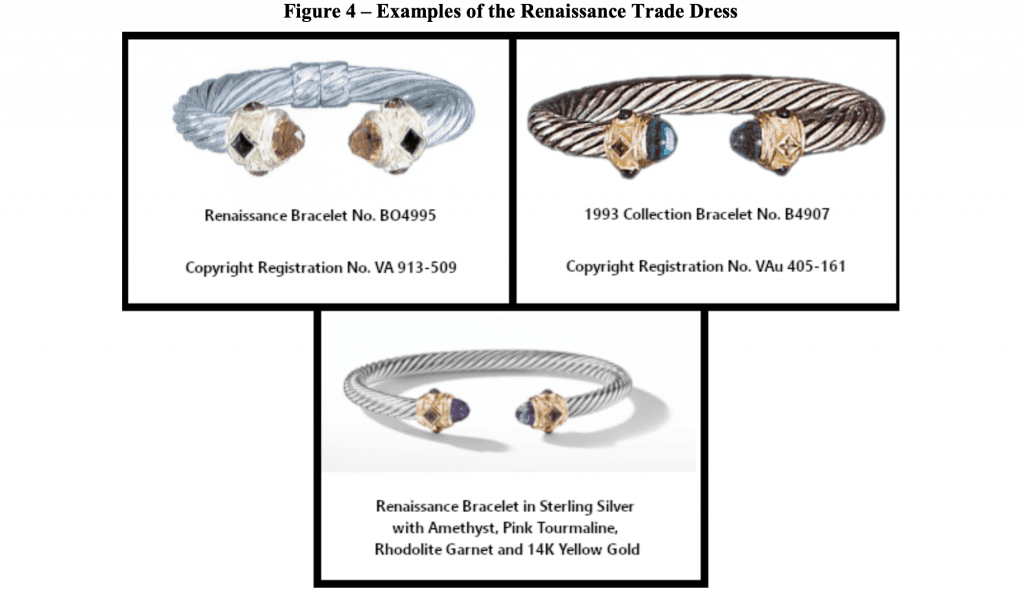A new lawsuit provides a peek into the stunning scope of (some of) the copyright and trademark rights that David Yurman boasts in its collection of jewelry products. In the 94-page complaint that it filed with the U.S. District Court for the Southern District of New York on Tuesday, David Yurman claims that Royal Chain Inc. is “misappropriat[ing] [its] intellectual property and undermin[ing] its market position by offering for sale and selling jewelry that copies the designs of iconic David Yurman jewelry pieces, thereby infringing upon Yurman’s world-famous trade dress and trademarks and infringing upon its copyrights.”
According to David Yurman, Royal Chain is engaging in “calculated and systematic” copying, in furtherance of which it seeks to “imitate Yurman jewelry pieces across multiple distinct collections, including by copying structure, insignia, and design flourishes that distinguish Yurman jewelry designs.” As a result of Royal Chain’s practice of “methodically replicat[ing] the distinctive features of Yurman bracelets, rings, necklaces, pendants, earrings, and chains,” David Yurman wages claims of unregistered trade dress infringement and unfair competition; federal copyright infringement; registered trademark infringement under the Lanham Act; and related claims of trade dress infringement and unfair competition under New York common law.
Delving into its rights, Yurman states in the newly-filed suit, as first reported by TFL, that its “iconic designs are protected by numerous common law and federally-registered copyrights and trademarks … and numerous of the designs are so associated with Yurman as to constitute protected trade dress.”
Yurman’s Trade Dress Rights
Turning first to its trade dress rights, Yurman cites its rights in the Cable Classic trade dress, the Helena Neck trade dress, the Helena Center Station trade dress, the Renaissance trade dress, the Yurman X trade dress, the Stacked Cable trade dress, the Crossover trade dress, the Alternating Cable Chain trade dress, the Adorned Bracelet trade dress, and the Streamline Tag trade dress, which it claims have been infringed by Royal Chain, which touts itself as “the industry’s leading supplier of gold jewelry.”

In one example, Yurman alleges that due to its “innovative designs, extensive promotion, and reputation for quality and elegance, the underlying design of certain jewelry pieces from Yurman’s Cable Classics Collection®, The Thoroughbred Collection®, and other related collections has become inextricably associated with the Yurman brand and constitutes a protected trade dress (the ‘Cable Classic Trade Dress’) such that consumers identify Yurman as the source of any jewelry pieces embodying the Cable Classic trade dress.” Yurman claims that it has “uninterruptedly sold and marketed numerous jewelry pieces embodying the Cable Classic trade dress since at least 1993” and sets out the elements of that trade dress as follows …
– A bracelet design comprising Yurman’s signature twisted helix cable configuration, which presents the external appearance of between 6 and 10 individual strands of material entwined with one another to form a single cable;
– A relatively thin (between 3mm and 8mm in thickness), flexible, open cuff bracelet design, comprising an incomplete circular loop of sterling silver, yellow gold, rose gold, or similar precious metals, incorporating a single gap measuring approximately 10-20mm across;
– Rounded and smooth ridges along the length of the twisted cable portion of the bracelet;
– A raised neck at each open end of the bracelet design comprising between 1 and 5 raised bands of sterling silver, yellow gold, rose gold, or similar precious metals; and
– A tapered design from each raised neck to the open ends of the bracelet, which are capped in a rounded shape comprising precious stones, minerals, pearls, or precious metals.
Broadly reflecting on its trade dress rights across its various jewelry collections, Yurman states that it advertises products incorporating the trade dress “extensively,” with such advertisements including “print advertisements in local, regional, and national magazines and newspapers, digital advertisements such as social media and influencer posts, and direct advertising via email and digital search ads.” The New York-based jewelry company further asserts that it “has spent millions of dollars on such advertising,” that such efforts “have led to sales of products incorporating [its] trade dress amounting to hundreds of millions of dollars,” and that the trade dress “has achieved a high degree of consumer recognition and secondary meaning through Yurman’s widespread use, sale, advertising, and promotion of jewelry pieces embodying the trade dress.”
Yurman’s Registered Copyrights & Trademarks
Not limited to protecting its pieces by establishing them as “well-known” trade dress, Yurman contends that “a number of expressions of the Yurman trade dress constitute original works of authorship created by Yurman and [are] protected by copyright.” Among the six registrations that Yurman points to in its complaint, Yurman states that “two of the exemplary Yurman jewelry items embodying the Cable Classic trade dress are also covered by copyright registrations (Reg. No. VAu 405-161 and VA 1-038-299),” making it so that these items are protected by “copyrights in addition to being protected as embodiments of the Cable Classic trade dress.”

Rounding out its claims, Yurman maintains that its Twisted Cable Bracelet design is a registered trademark, consisting of “an open twisted-cable bracelet design with faceted stones at each end. The portions of the bracelet shown in broken lines are intended solely to indicate the positioning of the mark and are not part of the mark.” The company similarly maintains a registration for the configuration of its Renaissance Cable Bracelet design and the “Renaissance” word mark, which are allegedly being infringed by Royal Chain.
What About Dilution?
While Yurman does not make any dilution claims in its complaint, it cites the fame of at least a few of its designs. In what feels like it could be a dilution claim in the making (although, it isn’t), Yurman asserts that “the wrongful reproduction of [its] protected designs … has the natural and intended effect of eroding the goodwill associated with the Yurman brand.”
In terms of the requisite level of fame, the jewelry company might be close when it comes to some of its pieces like the ones that fall into its “Cable Classics” collection. The company has been consistently offering up, advertising, and generating the bulk of its sale from its signature cable bracelet, for instance, since 1983. In the complaint, Yurman does touch on the element of fame, asserting that its Helix Cable Designs are “well known and famous and have been for decades,” citing an article from the New York Times, which referred to the cable designs as “the David Yurman brand’s DNA,” and Vogue commentary that the cable bracelet is “one of the reasons [the Yurman brand] been successful for so long.”
Yurman also states that the Helix Cable Designs “routinely attract unsolicited media coverage, much of which comments on the iconic nature of the Yurman Helix Cable Designs and the strong association between them and the brand itself.” Still, it does not go so far as to make a dilution claim, though.
In light of Royal Chain’s alleged misappropriation, Yurman argues that it is entitled to injunctive relief and damages.
The Bottom Line: The scope of Yurman’s portfolio will not surprise practitioners in the jewelry space, but it is, nonetheless, a noteworthy example of what Knobbe Martens’ Charlene Azema, Bita Kianian, and Robb Roby have called the “many different types of IP strategies that can be used to protect valuable jewelry designs.” They note that “when building an IP strategy, it is important to remember that these different types of protections are not mutually exclusive; a single design could be protected via a variety of different strategies, [which] requires planning and a bit of foresight. Nevertheless, having a robust IP portfolio in place with multiple enforcement options at one’s disposal would be the ultimate crown jewel.”
A representative for Royal Chain told TFL, “We are currently reviewing the complaint. David Yurman has a history of being litigious, and we find the claims baseless. Royal Chain has a sterling reputation serving the jewelry industry with honesty and integrity for over 45 years.”
The case is David Yurman v. Royal Chain, Inc., 1:23-cv-08224 (SDNY).


